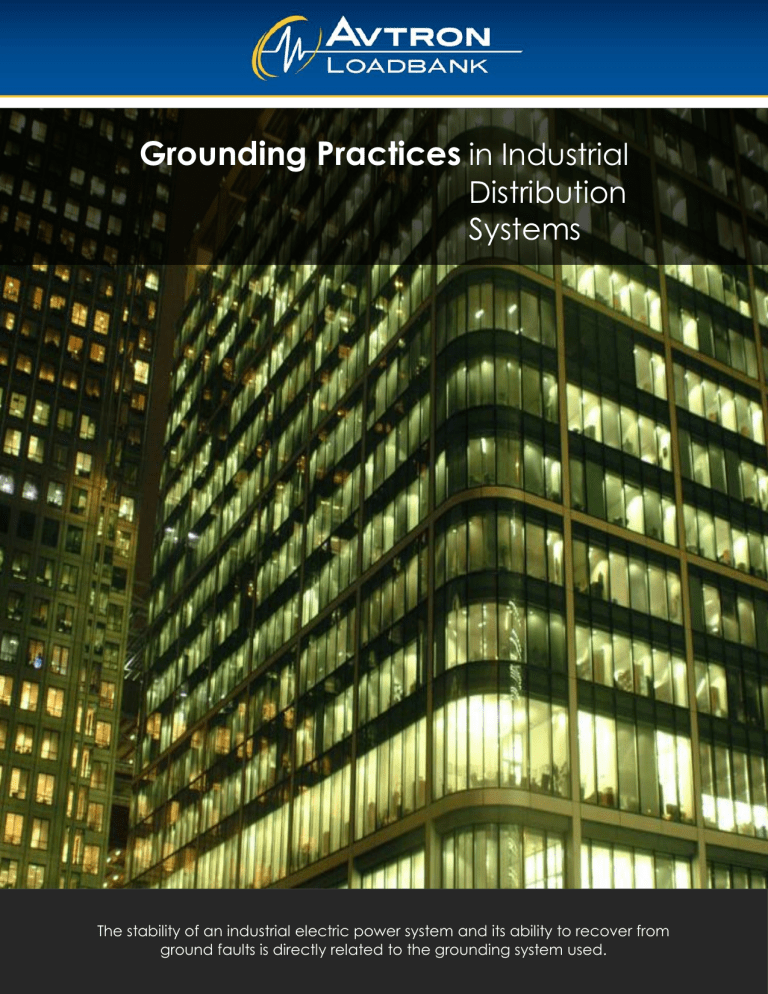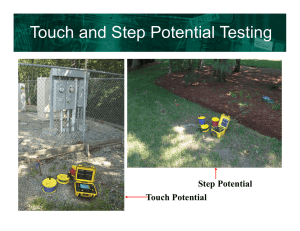White Paper Template - Emerson Network Power

Grounding Practices in Industrial
Distribution
Systems
The stability of an industrial electric power system and its ability to recover from ground faults is directly related to the grounding system used.
Executive Summary
Overview
For industrial and commercial distribution systems, the system’s ability to recover from a ground fault and its overall stability is directly related to the grounding system used. Most three-phase electric systems are either ungrounded, effectively (solidly) grounded, or grounded through a resistance. For industrial systems, the load is typically characterized by motors, transformers, control centers, etc. and experience has shown that these systems are more susceptible to ground faults and require the added protection. To adequately protect this high investment area, grounding practices must be carefully considered.
“100% System Availability for Industry is expected and must be designed in”
The following is a brief description of the relative merits of the three grounding techniques.
Ungrounded
systems are those in which no intentional connection is made between any part of the system and ground. However, an electrical system is always capacitively grounded because of coupling through the inherent shunt capacitance that exists between the conductors and ground. In a balanced system with no loads connected between line and neutral, the neutral is held at ground potential because of the presence of this shunt capacitance. Line to neutral voltage equals line-to-ground voltage and the neutral-to-ground voltage is zero.
Grounding Methods and System Protection 2
Under balanced conditions, a charging current (I capacitive reactance (X c
) flows through the co
) between each phase and ground. However, because each current is displaced by 120 deg, the vectoral summation at ground is zero.
When a ground fault occurs, a fault current of several amperes flows.
Because the faulted phase assumes ground potential, the neutral potential (Fig 1) is displaced from ground by an amount equal to the lineto-neutral voltage (V ph
). Now the voltage between each of the healthy phases and ground rises to the line-to-line value. (Line-to-line voltage =
3
V ph
). The resulting increase in voltage across the shunt capacitance causes the current between each of the two healthy phases and ground to increase by a factor of
3
. And since the currents are displaced by only
60 deg, the vectoral summation at ground is 3I c
.
An ungrounded system can continue to operate with a ground fault, provide that the ground fault current (3I c
) does not rise above a few amperes and the phase-to-ground voltage of the healthy phases do not rise above the line-to-line voltage. This allows production to be continued until the end of the shift or day and the fault located when the plant is normally shut down.
However, experience with ungrounded systems has shown that substantial overvoltages can develop. The presence of capacitance and inductance in the system leads to arcing and intermittent spluttering type faults, which cause the system voltage to escalate to dangerously high values (up to six times the normal value have been produced in laboratory tests). Over-stressing of the insulation and failures in system components can he caused by voltages of this magnitude. Transient overvoltages, especially in the medium-voltage systems, increase the probability of failures and generally outweigh any advantages an ungrounded system might offer.
Effectively-grounded
(solidly-grounded) systems have a direct connection between the neutral and ground, with no intentional impedance (Fig 2). Utility distribution systems have a neutral wire which parallels the three-phase conductors for the length of the distribution line, and is grounded at intervals.
Effectively-grounded systems are not subject to transient overvoltages which result from intermittent ground faults. The
Grounding Methods and System Protection 3
solid ground stabilizes the neutral voltage and prevents elevation of the phase-to-ground voltage.
If the neutral is available for connection, effective grounding involves no additional equipment and is the least expensive method. However, the ground fault current is limited only by the arc and stray return path impedances which are small, resulting in high fault current. Extensive and time consuming repairs may be needed after a ground fault on an effectively-grounded system. This is especially true of low voltage (<600V), where this method of grounding presents a substantial protection problem.
Resistive-grounding
systems have an essentially resistive impedance inserted between the neutral and ground (Fig 3). This method of grounding has the advantages of both the ungrounded and effectivelygrounded systems, while eliminating most of their disadvantages. For example, the potentially dangerous system overvoltages caused by arcing-type ground faults is suppressed by dissipating the energy in the resistor. Safety to personnel and system stability are significantly improved.
The mitigation of a ground fault's damaging effects and resulting hazards to personnel are even more pronounced when compared to solid grounding. A useful rule of thumb: The energy released and the damage done by a fault is approximately proportional to the square of the fault current multiplied by fault duration. If the fault current is reduced from
Grounding Methods and System Protection 4
10,000 amp with solid grounding to 100 amp with resistance grounding, the magnitude of the fault energy is reduced by a factor of 10,000. The table summarizes system characteristics as a function of the grounding method used.
Characteristics of Different Grounding Methods
Characteristic Ungrounded High Resistance Low Resistance Effective
Transient Overvoltages
Positive Fault Location
Up to 6 p.u.
No
2.5 p.u.
Yes
2.5 p.u.
Yes
2.5 p.u.
Yes
System Interruption on First Fault
Personnel Safety
Multiple Faults
Sometimes
Poor
Often
Optional
Best
Seldom
Yes
Good
Seldom
Yes
Fair
Seldom
Fault Damage
Coordination of Protective
Relay
Low
Impossible
Low
Best
Low
Best
High
Good
High or Low-resistance Grounding
There are two types of resistive grounding: high- and low-resistance. Within each category, there are several configurations which allow system designer flexibility.
Low-resistance grounding
provides a ground fault current typically between
25 and 2000 amp. The magnitude of the ground fault current must be at least as large as the current flowing through the system’s shunt capacitance for the resistance to adequately limit the transient overvoltages. The protection scheme is optimized by selecting a fault level low enough that fault damage is minimized while still allowing enough current to operate relays selectively.
Because the fault is cleared quickly by relays, damage to equipment is minimized. The fast response time also improves personnel safety, prevents additional faults from occurring, and limits overheating and mechanical stress on conductors.
High-resistance grounding
uses a resistance which a sized to limit the ground fault current to slightly higher than the capacitive current and typically no more than 10 amp (R< Xco ) . If possible, the ground fault current should be large
3 enough to allow for system growth. The fault current in high-resistance-grounded systems is low enough to permit continued operation while the fault is located and a scheduled shutdown can be arranged for repairs. Fault tracking in highresistance-grounded systems can he accomplished without circuit interruption.
The common detection system uses a relay to sense the voltage which appears across the resistor under fault conditions. (The relay usually includes a time delay to filter out transient and nuisance indications.) Once a fault is detected, it is annunciated locally and/or remotely.
Grounding Methods and System Protection 5
To locate the fault, a technician initiates a control circuit which produces a tracer signal. Typically, 40 current pulses/min are used. This signal is easily distinguished from background noise. The pulses can be traced to the fault with a very sensitive split-core window ammeter.
Zigzag or Wye-Delta Grounding (Interconnected Star or Star
Delta)
In some power systems the neutral may not be available, as in wye-connected
(star connected) transformers or generators. This is also true in many older low voltage systems and in existing medium voltage systems. To earth these systems and to derive a system neutral, grounding transformers are required to create an artificial neutral.
The zigzag (interconnected star) transformer is a three-phase autotransformer with no secondary winding. Each limb of the transformer has two identical windings wound differentially so that, under normal conditions, the total flux in each limb is negligible. Consequently, the transformer draws very little magnetizing current.
The grounding transformers are typically of short time ratings, usually 10 seconds to one minute. Therefore, the sizes of such transformers are small compared to the power transformer of the same ratings. The resistor connection is made directly to the transformer neutral and earth, and sized to permit low ground fault currents typically in the vicinity of 5A ).
Grounding Methods and System Protection 6
Summary
In industry today, there is an increasing demand for service continuity of power distribution systems. To achieve the maximum system availability and benefits of grounding, resistive grounding is often the method of choice. The use of larger (and more expensive) motors is commonplace and protecting this investment is as critical as avoiding the downtime. For today’s industrial environments, it is not surprising that resistive grounding is the consensus among design engineers.
For more information please contact us
Name: Avtron LoadBank, Inc.
Address: 6255 Halle Drive
Independence, OH 44125 USA
Email: LBsales@Emerson.com
Website: www.avtronloadbank.com
Tel:
Fax:
(216) 573-7600
(216) 573-5953
More Information
For the latest information about our product and services, please see the following resources:
Reference websites: www.avtronloadbank.com
Grounding Methods and System Protection 7
Copyright ©2010 Avtron LoadBank, Inc. All Rights Reserved.
Avtron LoadBank, Inc. logos, and trademarks or registered trademarks of Avtron LoadBank, Inc. or its subsidiaries in the United States and other countries.
Copyright ©2010 Avtron LoadBank, Inc. All Rights Reserved.
Other names and brands may be claimed as the property of others. Information regarding third party products is provided solely for educational purposes.
Avtron LoadBank, Inc. is not responsible for the performance or support of third party products and does not make any representations or warranties whatsoever regarding
Grounding Methods and System Protection 8

